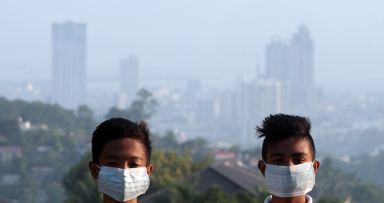
| CDN file photo
CEBU CITY, Philippines – Hazy skies settled over Cebu City on Thursday morning, November 14, 2024, prompting officials to warn residents, especially those with respiratory conditions, of potential health risks.
The Environmental Management Bureau in Central Visayas (EMB-7) confirmed that climate-induced air pollution, combined with a meteorological phenomenon known as temperature inversion, caused the haze across the city.
READ MORE:
EXPLAINER: Haze in Cebu City -How and why it happened?
Light haze in Cebu City may prevail until Friday
Light haze blankets Cebu City, Pagasa confirms
Understanding air pollution’s health risks
Dr. Peter Mancao, officer-in-charge at Cebu City Medical Center (CCMC), explained that air pollution exposes the body to harmful contaminants such as particulate matter, ozone, and nitrogen dioxide, all of which enter the respiratory tract.
These pollutants contribute to inflammation and oxidative stress, and they are linked to serious health outcomes affecting various organs, particularly the lungs, heart, and brain.
Air pollution increases the risk for cardiovascular diseases, chronic respiratory conditions, and even cancer, with the potential for both immediate and long-term impacts on health.
“Ang health risk gyud aning haze kay respiratory tract infection kay mo-enter mana siya sa ato respiratory tract. Mao na kung prolong imo exposure sa gawas magsuot nalang gyud og mask,” Mancao said.
(The health risks of haze is respiratory tract infection because it enters our respiratory tract. That’s why when you’re going to be exposed for a prolonged period, just wear a mask.)
“Naay mga tawo nga hubakon man gud then naa sad mga tawo nga naay allegies sa dust so kini sila dapat andam na gyud ni sila nga magsuot na og mask,” he added.
(There are some asthmatic and then there are also some who have allergies to dust so these are the people who should be wearing masks.)
Temperature inversion and haze formation
According to the Philippine Atmospheric Geophysical and Astronomical Services Administration (Pagasa) in Mactan, the haze resulted from a temperature inversion that trapped cooler air beneath warmer air, preventing pollutants from dispersing.
Normally, air temperatures drop with increased altitude, allowing pollutants to rise and dissipate. However, recent typhoons altered these weather patterns, causing pollutants to accumulate within breathable levels of the atmosphere.
“There have been typhoons, very frequent in the same area and in the same period. So ating temperature, they prevented the tiny particles to go up and disperse that quick,” EMB-7 explained.
EMB-7 also ruled out other sources, such as volcanic activity or forest fires, as causes for the haze. The combination of climate events and high pollutant levels led to the visible haze affecting the city.
Advisory for at-risk populations
Although pollution levels remained within safe standards, EMB-7 urged preventive measures for the elderly, children, and individuals with pre-existing respiratory conditions.
“It’s not alarming. It’s not serious (threats)… We still don’t have precautionary measure but for the vulnerable sector. For our senior, our children… they can wear masks for protection,” it added.
Data from November 12 showed pollution levels at 32 micrograms per cubic meter, which doubled to 65 micrograms by November 14.
Despite this increase, air quality remained below the critical 150-microgram threshold, but authorities still recommended caution for those sensitive to air pollutants.
Long-term health implications
The health expert from CCMC noted that both short-term and prolonged exposure to pollutants can aggravate respiratory infections, asthma, and cardiovascular conditions.
He said that children, pregnant women, and the elderly face higher risks due to compromised immune responses and increased vulnerability to pollutants.
Air pollution not only impacts respiratory health but is also linked to broader health risks, including cognitive impairment and neurological issues in children.
Safety recommendations for the public
To minimize exposure, health professionals and other authorities recommend limiting outdoor activities during high-pollution periods, keeping windows closed, and wearing protective masks when venturing outside.
These preventive measures, particularly for sensitive groups, are vital in reducing immediate and long-term health risks associated with air pollution.
As haze conditions are expected to persist until Friday, November 15, EMB-7 and Pagasa-Mactan encourage the public to stay informed and adhere to health guidelines, especially those within high-risk categories. /with reports from Morexette Marie Erram, Futch Anthony Inso